Sony CDPCE-275 Service manual
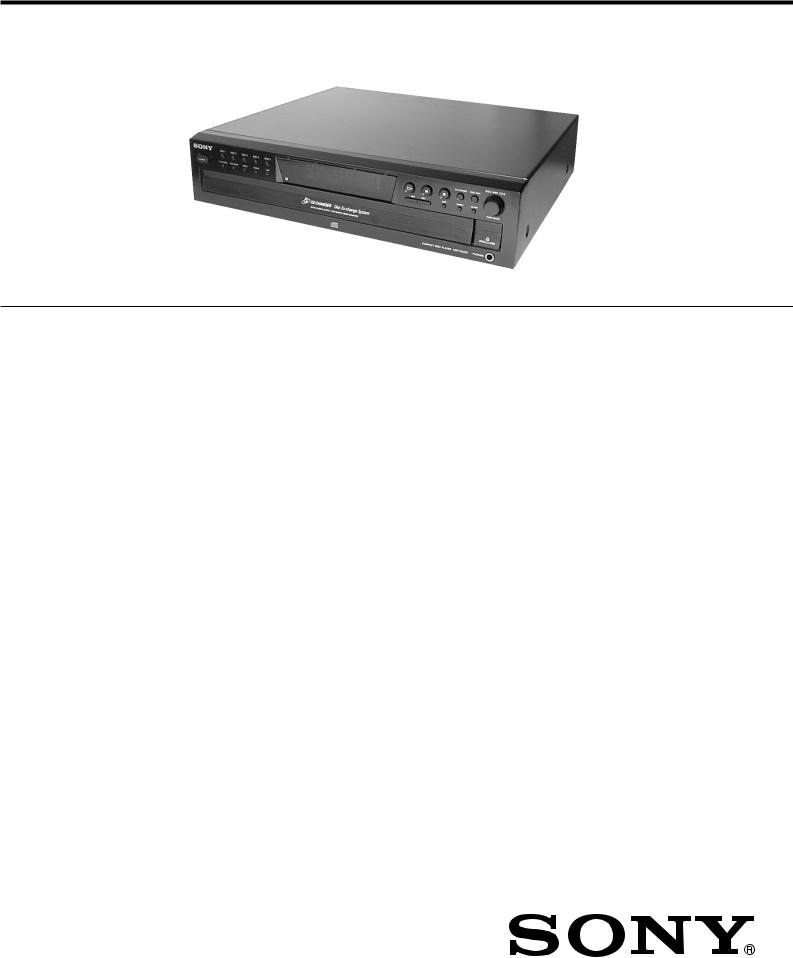
CDP-CE275/CE375
SERVICE MANUAL |
US Model |
|
Ver 1.1 2001.07 |
Canadian Model |
|
Australian Model |
||
|
||
|
CDP-CE275/CE375 |
|
|
AEP Model |
|
|
UK Model |
|
|
E Model |
|
|
CDP-CE375 |
Photo: CDP-CE375
Model Name Using Similar Mechanism |
CDP-CE345 |
|
|
CD Mechanism Type |
CDM59-5BD27 |
|
|
Base Unit Name |
BU-5BD27 |
|
|
Optical Pick-up Name |
PXR-104X |
|
|
SPECIFICATIONS
Compact disc player |
|
Laser |
Semiconductor laser ( λ = 780 nm) |
|
Emission duration : continuous |
Frequency response |
2 Hz to 20 kHz ± 0.5 dB |
Dynamic range |
More than 93 dB |
Harmonic distortion |
Less than 0.0045% |
Outputs
|
Jack |
Maximum |
Load |
|
type |
output level |
impedance |
ANALOG |
Phono |
2 V |
Over 10 |
OUT |
jacks |
(at 50 kilohms) |
kilohms |
|
|
|
|
DIGITAL |
Optical |
–18 dBm |
Wave |
OUT |
output |
|
length: |
(OPTICAL) |
connector |
|
660 nm |
PHONES |
Stereo |
10 mW |
32 ohms |
(CDP-CE375 |
phone |
|
|
only) |
jack |
|
|
General |
|
Power requirements |
120 V AC, 60 Hz |
Power consumption |
11 W |
Dimensions (approx.) |
430 x 110 x 400 mm |
(w/h/d) |
(17 x 4 3/8 x 15 3/4 in.) |
|
incl. projecting parts |
Mass (approx.) |
5 kg (11 lbs 1 oz) |
Supplied accessories
Audio cord (2 phono plugs – 2 phono plugs) (1) Remote commander (remote) (1) (CDP-CE375 only) R6 (size AA) batteries (2) (CDP-CE375 only)
Design and specifications are subject to change without notice.
COMPACT DISC PLAYER
9-873-822-12 |
Sony Corporation |
2001G0500-1 |
Home Audio Company |
C 2001.7 |
Shinagawa Tec Service Manual Production Group |

CDP-CE275/CE375
Ver 1.1 2001.07
|
TABLE OF CONTENTS |
|
1. |
SERVICING NOTES ............................................... |
3 |
2. |
GENERAL ................................................................... |
4 |
3. |
DISASSEMBLY ......................................................... |
5 |
4. |
TEST MODE .............................................................. |
10 |
5. |
ELECTRICAL ADJUSTMENTS ......................... |
13 |
6.DIAGRAMS
6-1. Note for Printed Wiring Boards |
|
|
|
and Schematic Diagrams ................................................ |
15 |
6-2. |
Printed Wiring Board – BD Board – ............................. |
16 |
6-3. |
Schematic Diagram – BD Board – ................................ |
17 |
6-4. |
Printed Wiring Boards – JUNCTION/SENSOR/ |
|
|
LOADING MOTOR Boards – ........................................ |
18 |
6-5. |
Schematic Diagram – JUNCTION/SENSOR/ |
|
|
LOADING MOTOR Boards – ........................................ |
19 |
6-6. |
Printed Wiring Board – MAIN Board – ........................ |
20 |
6-7. |
Schematic Diagram – MAIN Board – ........................... |
21 |
6-8. |
Printed Wiring Boards – PANEL Section – .................. |
22 |
6-9. |
Schematic Diagram – PANEL Section – ....................... |
23 |
6-10. IC Pin Function Description ........................................... |
26 |
|
7. |
EXPLODED VIEWS ................................................ |
30 |
8. |
ELECTRICAL PARTS LIST ............................... |
35 |
SAFETY-RELATED COMPONENT WARNING!!
COMPONENTS IDENTIFIED BY MARK 0 OR DOTTED LINE WITH MARK 0 ON THE SCHEMATIC DIAGRAMS
AND IN THE PARTS LIST ARE CRITICAL TO SAFE OPERATION. REPLACE THESE COMPONENTS WITH SONY PARTS WHOSE PART NUMBERS APPEAR AS SHOWN IN THIS MANUAL OR IN SUPPLEMENTS PUBLISHED BY SONY.
ATTENTION AU COMPOSANT AYANT RAPPORT
À LA SÉCURITÉ!
LES COMPOSANTS IDENTIFIÉS PAR UNE MARQUE 0
SUR LES DIAGRAMMES SCHÉMATIQUES ET LA LISTE DES PIÈCES SONT CRITIQUES POUR LA SÉCURITÉ DE FONCTIONNEMENT. NE REMPLACER CES COMPOSANTS QUE PAR DES PIÈCES SONY DONT LES NUMÉROS SONT DONNÉS DANS CE MANUEL OU DANS LES SUPPLÉMENTS PUBLIÉS PAR SONY.
SAFETY CHECK-OUT
After correcting the original service problem, perform the following safety check before releasing the set to the customer:
Check the antenna terminals, metal trim, “metallized” knobs, screws, and all other exposed metal parts for AC leakage.
Check leakage as described below.
LEAKAGE TEST
The AC leakage from any exposed metal part to earth ground and from all exposed metal parts to any exposed metal part having a return to chassis, must not exceed 0.5 mA (500 microamperes.). Leakage current can be measured by any one of three methods.
1.A commercial leakage tester, such as the Simpson 229 or RCA WT-540A. Follow the manufacturers’ instructions to use these instruments.
2.A battery-operated AC milliammeter. The Data Precision 245 digital multimeter is suitable for this job.
3.Measuring the voltage drop across a resistor by means of a VOM or battery-operated AC voltmeter. The “limit” indication is 0.75 V, so analog meters must have an accurate lowvoltage scale. The Simpson 250 and Sanwa SH-63Trd are examples of a passive VOM that is suitable. Nearly all battery operated digital multimeters that have a 2 V AC range are suitable. (See Fig. A)
To Exposed Metal
Parts on Set
|
|
|
|
|
AC |
0.15 µ F |
|
|
|
1.5 kΩ |
voltmeter |
|
|
|
|
|
(0.75 V) |
|
|
|
|
|
|
Earth Ground
Fig. A. Using an AC voltmeter to check AC leakage.
2
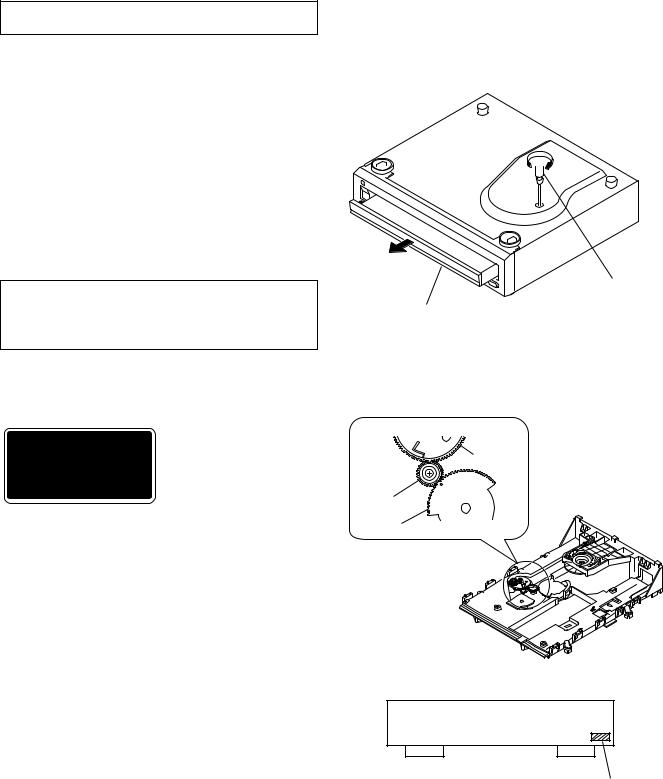
CDP-CE275/CE375
SECTION 1
SERVICING NOTES
NOTES ON HANDLING THE OPTICAL PICK-UP BLOCK OR BASE UNIT
The laser diode in the optical pick-up block may suffer electrostatic break-down because of the potential difference generated by the charged electrostatic load, etc. on clothing and the human body.
During repair, pay attention to electrostatic break-down and also use the procedure in the printed matter which is included in the repair parts.
The flexible board is easily damaged and should be handled with care.
NOTES ON LASER DIODE EMISSION CHECK
The laser beam on this model is concentrated so as to be focused on the disc reflective surface by the objective lens in the optical pick-up block. Therefore, when checking the laser diode emission, observe from more than 30 cm away from the objective lens.
CAUTION
Use of controls or adjustments or performance of procedures other than those specified herein may result in hazardous radiation exposure.
This appliance is classified as a CLASS 1 LASER product. The CLASS 1 LASER PRODUCT MARKING is located on the rear exterior.
LASER DIODE AND FOCUS SEARCH OPERATION CHECK
Carry out the “S curve check” in “CD section adjustment” and check that the S curve waveforms is output three times.
Notes on chip component replacement
•Never reuse a disconnected chip component.
•Notice that the minus side of a tantalum capacitor may be damaged by heat.
Flexible Circuit Board Repairing
HOW TO OPEN THE DISC TABLE WHEN POWER SWITCH TURNS OFF
Insert a tapering driver into the aperture of the unit bottom, and turn it in the direction of the arrow (to OUT direction).
tapering driver
table
*To close the disc table, turn the tapering driver in the reverse direction (to IN direction).
NOTE FOR MAIN GEAR INSTALLATION
gear, swing
gear (RV)
gear (U/D)
MODEL IDENTIFICATION
– BACK PANEL –
•Keep the temperature of the soldering iron around 270 ˚C during repairing.
• Do not touch the soldering iron on the same conductor of the circuit board (within 3 times).
•Be careful not to apply force on the conductor when soldering or unsoldering.
|
Part No. |
|
|
Model |
Part No. |
|
|
CDP-CE275: US model |
4-233-719-0s |
CDP-CE275: Canadian model |
4-233-719-1s |
|
|
CDP-CE275: Australian model |
4-233-719-2s |
|
|
CDP-CE375: US model |
4-233-718-0s |
CDP-CE375: Canadian model |
4-233-718-1s |
|
|
CDP-CE375: AEP model |
4-233-718-2s |
CDP-CE375: UK model |
4-233-718-3s |
|
|
CDP-CE375: Australian model |
4-233-718-4s |
CDP-CE375: E model |
4-233-718-5s |
CDP-CE375: Singapore model |
4-233-718-6s |
3
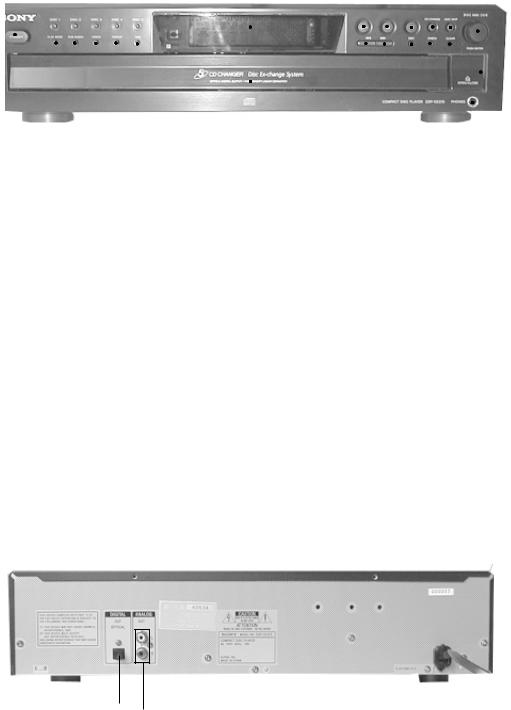
CDP-CE275/CE375
SECTION 2
GENERAL
• LOCATION OF CONTROLS
– Front panel –
|
|
2 |
|
|
|
|
|
|
|
|
|
8 |
|
||
1 |
3 |
4 5 |
6 |
7 |
|
9 |
|||||||||
|
|
|
|||||||||||||
|
|
|
|
|
|
|
|
|
|
|
|
||||
|
|
|
|
|
|
|
|
|
|
|
|
|
|
|
|
|
|
|
|
|
|
|
|
|
|
|
|
|
|
|
|
|
|
|
|
|
|
|
|
|
|
|
|
|
|
|
|
|
|
|
|
|
|
|
|
|
|
|
|
|
|
|
|
|
|
|
|
|
|
|
|
|
|
|
|
|
|
|
|
|
|
|
|
|
|
|
|
|
|
|
|
|
|
|
|
|
|
|
|
|
|
|
|
|
|
|
|
|
|
|
|
|
|
|
|
|
|
|
|
|
|
|
|
|
|
|
|
|
|
|
|
|
|
|
|
|
|
|
|
|
|
|
|
|
|
|
|
w; |
|
qk |
|
|
|
qg |
|
|
|
|
|
|
|
|
|
|
|||
|
ws |
|
|
|
|
|
|
|
|
|
|
|
|
|
|
|
|
|
|
|
|
|
|
|
|
|
ql |
|
|
|
|
qh |
qf |
|
|
qs |
|
|
|
|
|||||||
|
|
|
|
|
|
|
|
|
|
|
|
|
|
|
|||||||||
|
|
|
|
|
|
|
|
|
|
0 |
|||||||||||||
|
|
|
|
|
|
|
|
|
|
|
|
||||||||||||
|
|
|
wa |
|
|
|
|
|
|
|
|
|
|
|
|
|
|
||||||
|
|
|
|
qj |
|
|
|
|
|
|
qd |
|
|
||||||||||
|
|
|
|
|
|
|
|
|
|
|
|
|
|
|
|
|
|
|
|
||||
|
|
|
|
|
|
|
|
|
|
|
|
|
|
|
|
|
|
|
|
|
|
||
|
|
|
|
|
|
|
|
|
|
|
|
|
|
|
|
|
|
|
|
qa |
|||
1 |
POWER button |
|
|
|
|
|
|
|
qs |
CLEAR button |
|
|
|
|
|
|
|
|
|
|
|||
2 |
DISC1 – DISC5 button |
|
|
|
|
|
|
|
qd |
CHECK button |
|
|
|
|
|
|
|
|
|
|
|||
3 |
Fluorescent indicator tube display |
|
|
|
qf |
EDIT button |
|
|
|
|
|
|
|
|
|
|
|||||||
4 |
Hbutton |
|
|
|
|
|
|
|
qg |
Mbutton |
|
|
|
|
|
|
|
|
|
|
|||
5 |
Xbutton |
|
|
|
|
|
|
|
qh |
mbutton |
|
|
|
|
|
|
|
|
|
|
|||
6 |
xbutton |
|
|
|
|
|
|
|
qj |
Disc table |
|
|
|
|
|
|
|
|
|
|
|||
7 |
EX-CHANGE button |
|
|
|
|
|
|
|
qk |
TIME button |
|
|
|
|
|
|
|
|
|
|
|||
8 |
DISC SKIP button |
|
|
|
|
|
|
|
ql |
REPEAT button |
|
|
|
|
|
|
|
|
|
|
|||
9 |
lAMS Lcontrol |
|
|
|
|
|
|
|
w; |
FADER button |
|
|
|
|
|
|
|
|
|
|
|||
0 |
AOPEN/CLOSE button |
|
|
|
|
|
|
|
wa |
PEAK SEARCH button |
|
|
|
|
|
|
|
|
|||||
qa |
PHONES jack |
|
|
|
|
|
|
|
ws |
PLAY MODE button |
|
|
|
|
|
|
|
|
|
|
|||
– Rear panel –
1 2
1 DIGITAL OUT OPTICAL connector
2 ANALOG OUT
4
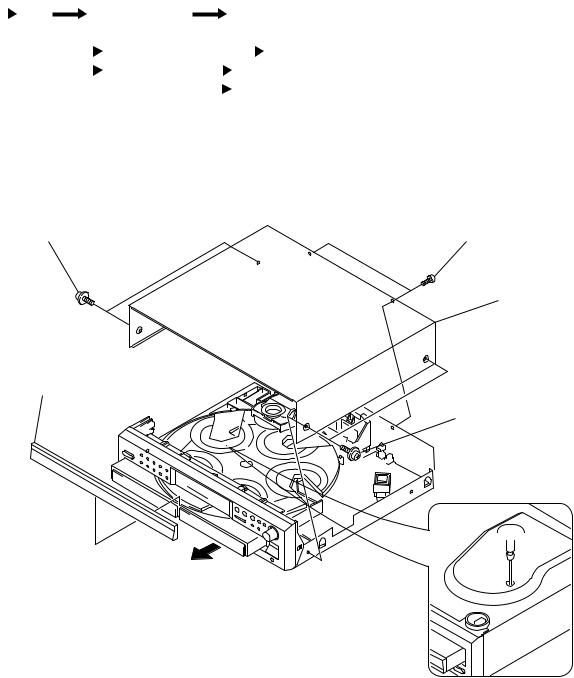
CDP-CE275/CE375
|
|
|
|
|
|
|
|
|
|
SECTION 3 |
||||
|
|
|
|
|
|
|
|
DISASSEMBLY |
||||||
• The equipment can be removed using the following procedure. |
|
|
|
|
|
|||||||||
Set |
|
Case |
|
Front Panel Assy |
CD Mechanism Block |
|
|
|
||||||
|
|
|
||||||||||||
|
|
|
||||||||||||
|
|
|
|
|
|
|
|
|
|
|
|
|
|
|
|
|
|
|
|
|
|
|
|
|
|
|
|
|
|
|
|
|
|
|
Base Unit (BU-5BD27) |
|
Optical Pick-up |
|||||||
|
|
|
|
|
|
|||||||||
|
|
|
|
|
|
|||||||||
|
|
|
|
|
Tray, Table Assy |
|
|
|
|
Sensor Board |
||||
|
|
|
|
|
|
|
|
|||||||
|
|
|
|
|
|
|
|
|||||||
|
|
|
|
|
|
|
|
|
|
Jnuction Board, Loading Motor Board |
||||
|
|
|
|
|
|
|
|
|
|
|||||
|
|
|
|
|
|
|
|
|
|
|||||
Note: Follow the disassembly procedure in the numerical order given.
3-1. CASE
2 two screws |
3 two screws |
(case 3TP2) |
(BVTP 3x8) |
|
4 case |
7 panel, loading
1 two screws (case 3TP2)

 5
5
6
5
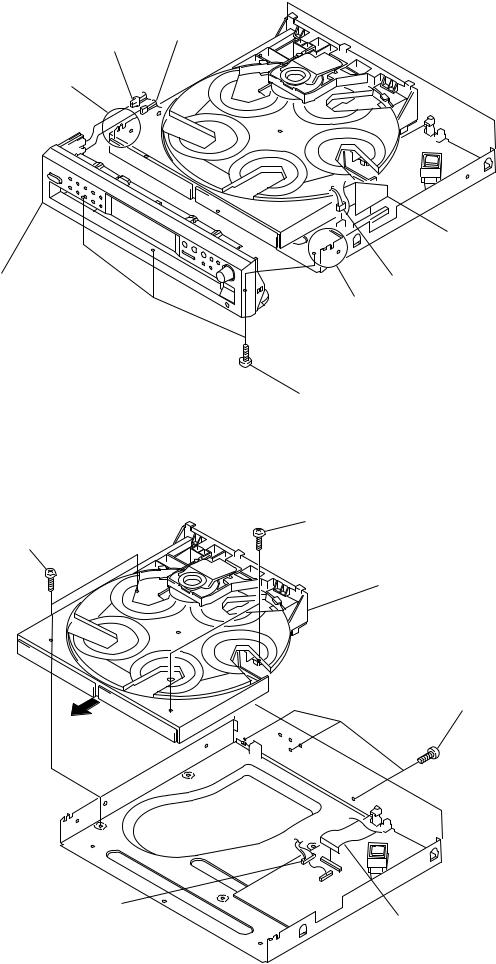
CDP-CE275/CE375
3-2. FRONT PANEL ASSY
2 CN602
1 CN601
7 claw
8 front panel assy
3-3. CD MECHANISM BLOCK (CDM59-5BD27)
4two screws (BVTP 3x8)
5 tray
2 CN311
3 CN301
4 CN351
6 claw
5three screws (BVTP 3x8)
6two screws (BVTP 3x8)
7 CDM59-5BD27
3 three screws (BVTP 3x8)
1 CN302
6

CDP-CE275/CE375
3-4. BASE UNIT (BU-5BD27)
|
3 two screws |
|
|
(+PTPWHM 2.6), |
2 two screws |
|
floating |
|
|
(+PTPWHM 2.6), floating |
|
|
|
|
|
|
7 base unit (BU-5BD27) |
6 spring (932), |
|
5 spring (932), |
compression |
|
|
|
compression |
|
|
|
4 holder (BU) assy
1 two screws
(+PTPWHM 2.6), floating
3-5. TRAY, TABLE ASSY
8 screw
(+PTPWHM 2.6), floating
9 tray
7 table assy
5
2 bracket (guide)
6 CN15
1 two screws |
3 three screws |
|
(M 2.6), +BTTP |
||
(M 2.6), +BTTP |
||
|
||
|
4 bracket (guide) |
7

CDP-CE275/CE375
3-6. SENSOR BOARD
1 belt (rotary)
table assy
4 SENSOR board
2 two screws
(M 2.6), +BTTP
3 two screws
(M 2.6), +BTTP
3-7. JUNCTION BOARD, LOADING MOTOR BOARD
6two screws
(M 2.6), +BTTP
4 JUNCTION board
2 CN13
7 LOADING MOTOR board
5 belt (loading)
1 CN14
3 three screws
(M 2.6), +BTTP
8
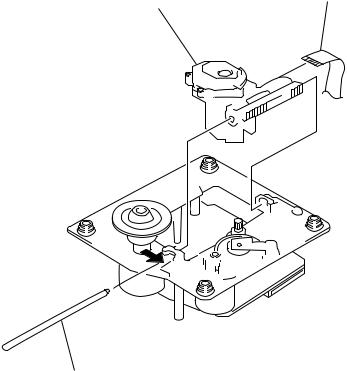
CDP-CE275/CE375
3-8. OPTICAL PICK-UP
4 connector
3 optical pick-up
1





2 shaft, sled
9
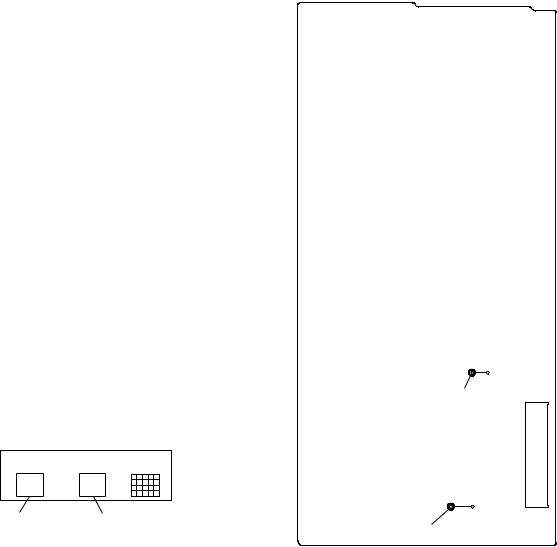
CDP-CE275/CE375
Ver 1.1 2001.07 |
SECTION 4 |
|
TEST MODE |
ADJ MODE
NOTE: This mode cannot be performed without a general remote commander.
1.Chuck the CD first, and then turn OFF the power.
2.Short-circuit the test point TP1 (ADJ) of the MAIN board and ground with a lead wire.
3.Press the [POWER] button to turn ON the power.
The CD is playback automatically and the ADJ mode is set.
4.To exit the mode, press the [POWER] button to turn OFF the power.
•Prohibits high speed search during accessing
•Ignores even if GFS becomes “L”
ADJ Mode Special Function Table
Button |
Function |
|
PLAY MODE |
Auto gain display |
|
(Focus, Tracking and Sledding) |
||
|
||
|
|
|
EDIT |
RFCK → GFS → Error rate display |
|
|
|
Connecting Location:
– MAIN BOARD (Component Side) –
FLUORESCENT INDICATOR TUBE ALL LIT, AND KEY CHECK MODE
1.Short-circuit the test TP2 (AFADJ) of the MAIN board and ground with a lead wire.
2.Press the [POWER] button to turn ON the power. The whole fluorescent indicator tube lights up.
3.All buttons have individual button numbers.
When a button is pressed, the button number is counted up and displayed.
JW66
TP1 (ADJ) |
CN301 |
|
10
JW68
Count up display |
Displays button number |
TP2 (AFADJ)
When remote controller signals are received, “RM **” will be displayed.
(** are the numbers corresponding to the remote controller buttons.)
When using the remote controller, switch the [CD1/2/3] switch to CD1.
4.To exit the mode, press the [POWER] button to turn OFF the power.
10

Buttons and Corresponding Button Numbers
Button |
Button Number or Display |
|
DISC1 |
12 |
|
|
|
|
DISC2 |
11 |
|
DISC3 |
10 |
|
|
|
|
DISC4 |
9 |
|
DISC5 |
8 |
|
PLAY MODE |
20 |
|
|
|
|
PEAK SEARCH |
19 |
|
FADER |
18 |
|
|
|
|
REPEAT |
17 |
|
TIME |
16 |
|
H (PLAY) |
Partial lighting 1 |
|
|
|
|
X (PAUSE) |
Partial lighting 2 |
|
x (STOP) |
All lit |
|
|
|
|
EX-CHANGE |
35 |
|
|
|
|
DISC SKIP |
36 |
|
m |
24 |
|
|
|
|
M |
25 |
|
EDIT |
26 |
|
|
|
|
CHECK |
27 |
|
|
|
|
CLEAR |
28 |
|
AMS (push) |
37 |
|
|
|
|
|
When rotated clockwise: The music calendar |
|
AMS (turn) |
numerals light up in ascending order. |
|
When rotated counterclockwise: The music |
||
|
||
|
calendar numerals light up in descending |
|
|
order. |
|
|
|
CDP-CE275/CE375
Ver 1.1 2001.07
All lit
|
ALL1DISCS |
|
1 |
|
2 |
3 |
4 |
5 |
|
PROGRAM |
|
|
|||||
|
|
|
|
|
|
|
|
|
REPEAT 1 |
SHUFFLE |
TRACK |
6 |
7 |
8 |
9 |
10 |
|
EDIT |
DISC |
PEAK MIN STEP SEC |
|
12 13 14 15 |
||||
TIME |
|
|
11 |
|||||
FADE |
|
|
16 |
17 18 19 20 |
||||
B |
|
|
||||||
Partial lighting 1
TRACK |
MIN |
SEC |
R
r Light altemately
ALL1DISCS |
|
1 |
2 |
3 |
4 |
5 |
|
|
|||||
DISC |
PEAK |
6 |
7 |
8 |
|
|
STEP |
|
|
|
|
Partial lighting 2
|
|
|
|
|
|
|
|
|
|
1 |
|
3 |
|
5 |
|
|
|
|
7 |
|
9 |
|
|
|
|
11 |
|
13 |
|
15 |
|
|
|
|
|
18 |
|
20 |
|
|
|
|
|
|
|
|
|
R |
Light altemately |
|
|
|
|
||
r |
|
|
|
|
|
|
|
|
|
|
|
|
|
||
|
|
|
|
|
|
||
|
|
|
2 |
|
4 |
|
|
|
|
6 |
|
8 |
|
10 |
|
|
|
|
12 |
|
14 |
|
|
|
|
16 |
17 |
|
19 |
|
|
|
|
|
|
|
|
|
|
11

CDP-CE275/CE375
Ver 1.1 2001.07
AGING MODE
For the aging mode, three modes of all mode, disc table mode, and loading mode are available.
This set has the Aging mode for operation check of the mechanism deck.
•If a failure occurred
The aging operation stops and a faulty status is displayed on the fluorescent indicator tube.
•If no failure occurs
The aging operation continues repeatedly.
Note: Do not use the test disc when performing aging.
Aging will not be performed properly if discs with tracks shorter than 4 seconds are used.
Procedure:
1.Press the [POWER] button and turn ON the power.
2.Set discs on all trays.
(More than two discs if five are not available)
3.All mode:
Press the [CHECK], [PLAY MODE] and x buttons at the same time. Disc table mode:
Press the [CHECK], [PLAY MODE] and [SKIP] buttons at the same time. Loading mode:
Press the [CHECK], [PLAY MODE] and [EX-CHANGE] buttons at the same time.
4.Aging starts, and the fluorescent indicator tube will display the following.
5.To exit the mode, press the [POWER] button to turn OFF the power.
Code No. |
Status |
All mode |
Disc table |
Loading |
Display in |
Display in |
|
mode |
|
mode |
Normal operation |
case of failure |
|||
|
|
|
|
||||
|
|
|
|
|
|
|
|
0 |
CLOSE (Tray closed) |
a |
|
|
a |
A-0 |
Err 0 |
1 |
TOC reading |
a |
a |
|
a |
A-1 |
Err 1 |
|
|
|
|
|
|
|
|
2 |
Access to last track |
a |
|
|
|
A-2 |
Err 2 |
|
|
|
|
|
|
|
|
3 |
Play of last track (3 sec) |
a |
|
|
|
Counter display |
Err 3 |
4 |
EX OPEN (Tray opened while chucking) |
a |
|
|
a |
A-4 |
Err 4 |
|
|
|
|
|
|
|
|
5 |
EX SKIP (Disc tray rotated) |
a |
|
|
|
A-5 |
Err 5 |
6 |
EX CLOSE (Tray closed) |
a |
|
|
a |
A-6 |
Err 6 |
|
|
|
|
|
|
|
|
7 |
Access to first track |
a |
|
|
|
A-7 |
Err 7 |
|
|
|
|
|
|
|
|
8 |
Play of first track (3 sec) |
a |
|
|
|
Counter display |
Err 8 |
9 |
OPEN (tray opened) |
a |
|
|
a |
A-9 |
Err 9 |
|
|
|
|
|
|
|
|
A |
DISC SKIP (Disc tray rotated, |
a |
a |
|
|
A-A |
Err A |
and next disc was selected) |
|
|
|||||
|
|
|
|
|
|
|
|
|
|
|
|
|
|
|
|
The discs are selectie in the order of DISC1 → DISC2 → |
DISC3 → |
DISC4 → |
DISC5 → DISC1 → .... Empty trays are skipped. |
||||
But the order is random in the disc table mode. |
|
|
|
|
|
|
|
MECHANISM DECK CHECK MODE
For the mechanism deck check mode, two modes of disc table mode and loading mode are available.
In the mechanism deck check mode, the disc table turning time and the loading time in each section are measured and displayed.
Procedure: |
|
|
|
|
|
|
|
|
|
Disc table mode: |
|
|
|
|
|
|
|
|
|
Press the [POWER] switch while pressing |
H |
, [A OPEN/CLOSE] and |
[REPEAT] buttons simultaneously. |
||||||
Loading mode: |
|
|
|
|
|
|
|
|
|
Press the [POWER] switch while pressing |
|
, [A OPEN/CLOSE] and |
[TIME] buttons simultaneously. |
||||||
H |
|||||||||
Display contents |
|
|
|
|
|
|
|
|
|
|
|
|
|
|
|
|
|||
Mode |
Check command |
Display |
|
|
|||||
Disc table mode |
0: Right one turn |
r 12.5 |
|
|
|||||
Table turning |
1: Left one Turn |
|
|
L 10.2 |
|
|
|||
( time measurement ) |
2: Measurement end |
r 12.5 |
|
|
|||||
|
3: Undefined |
|
|
|
|
|
|
|
|
|
|
|
|
|
|
|
|
||
|
4: Star position |
|
|
Sta |
– –.– |
|
|
||
|
5: Open → |
Close |
CLo |
10.2 |
|
|
|||
Table mode |
6: Close → |
BU up |
UP |
0.7 |
|
|
|||
7: BU up → |
EX open |
EoP |
6.2 |
|
|
||||
( Loadingmeasurementtime ) |
|
|
|||||||
8: EX open → |
EX close |
ECL |
10.3 |
|
|
||||
|
9: EX close → |
BU down |
don |
1.2 |
|
|
|||
|
A: BU down → |
|
Open |
oPn |
9.3 |
|
|
||
|
FF: Measurement end |
CLo |
10.2 |
|
|
||||
12
